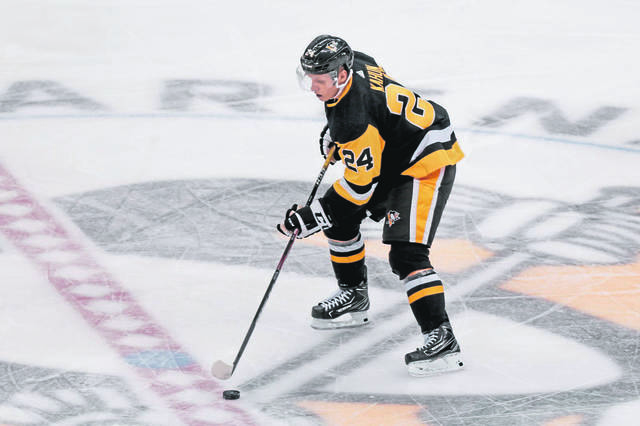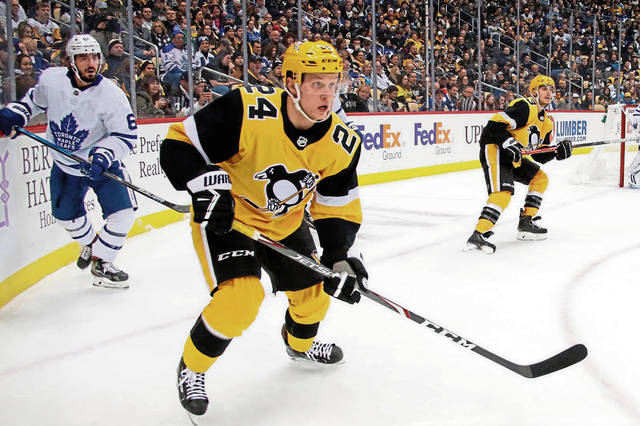Penguins' Dominik Kahun shows value in ragging the puck
The vocabulary of hockey can be intriguing.
There are plenty of terms that are self-explanatory, like a “slap shot” or the “blue paint.”
Others such as “barn” or “long change” require a brief conversation to explain.
Plenty of words sound like something cool. “Dangle” or “snipe” come to mind.
Then there is “rag.”
At face value, the phrase doesn’t appear pleasant or complimentary. But if you can rag the puck, you’re probably a good player.
At the least, you’re doing something right.
Such was the case for Dominik Kahun on Monday night.
During a three-on-three sequence in overtime, after fending off a handful of scoring chances by the Calgary Flames, Kahun claimed the puck and chugged up the right-wing boards toward the offensive zone.
As Kahun crossed the blue line, he sensed Flames defenseman Noah Hanifin closing in, then circled in front of the Penguins bench and back into the neutral zone. Hanging onto the puck, Kahun allowed tired teammates Alex Galchenyuk and John Marino to jump onto the bench while Jake Guentzel and Kris Letang replaced them for a badly needed line change.
As Guentzel sauntered his way to the center of the blue line, Kahun fed a pass to him, and Guentzel scored the winner in a 3-2 victory at PPG Paints Arena.
Guentzel got the adulation. But he made a point to laud Kahun’s ability to rag the puck in creating the opportunity.
“(Kahun) made a nice play on letting us change, getting me out there,” Guentzel said after the game. “He made a nice pass to me.”
Guentzel expanded on the sequence after practice Tuesday in Cranberry.
“That’s really smart,” he said. “Three-on-three, you’re trying to keep as much possession as you can. For him to allow two guys to change and then maybe get (the opponent) confused and try to get the counterattack, it’s a really good play by him.
“For him to pull up, go out of the zone and get time to get guys out there, it might go unnoticed, but you (appreciate) stuff like that.”
Said Kahun: “I was a little tired at the end there. … Even when I was in front of our net, I knew I wouldn’t be able to beat those guys. I need to figure something out. I recognized that (the defender) was going to catch me.”
While Kahun’s play netted him a primary assist, ragging a puck generally doesn’t manifest itself on a stat sheet.
Whether it’s a basic statistic similar to a goal or even a blocked shot or a more advanced metric such as Corsi, ragging kind of produces a “neutral” effect as far as analytics go.
Ideally, a player holds onto the puck and doesn’t attempt or allow a shot when ragging.
That doesn’t mean it doesn’t have a value.
“It’s huge,” forward Jared McCann said. “It can create chances for linemates. It can draws guys in. A lot of people focus on the puck when a guy has got it for a while, and they lose track of everybody else. That’s exactly what Dom did, and he’s probably one of our better players at it, for sure.”
Oftentimes, the most visible display of ragging occurs on a penalty kill when a defending player will try to skate with the puck in hopes of killing a few more seconds before firing a clearing attempt down ice.
But after the NHL instituted three-on-three overtime before the 2015-16 season, it’s a skill that has become more valuable.
“In overtime, it’s a key thing,” Kahun said. “You have to be smart. Don’t give pucks away. It wouldn’t be good if I just shot the puck from there and give it to them. I knew I had to make something, and I think it turned out pretty good.”
Ragging isn’t only more important in three-on-three sequences, but it also is easier with fewer bodies on the ice.
“Five on five, it’s a little different because you’ve got so many guys,” Kahun said. “It’s hard to keep the puck because they’re on you all the time. You obviously want to play with the puck. In overtime, you have more space. You can go away from people more.”
Perspicacity appeared to be a far more important attribute toward being a good ragger than any other physical trait.
“I don’t know if it’s difficult to practice, but it’s difficult to execute, for sure, because there’s a lot that goes it into it,” coach Mike Sullivan said. “It starts with the thought process first. You’ve got think it and see it before you can act on it. So to have the presence of mind to keep the puck, protect the puck, use his body, then have the puck poise to be able to make a play so that we can maintain possession, I think is a highly skilled play.”
In Monday’s game, it turned out to be a play that led to victory.
“It’s a great play, because No. 1, he was on the ice for a long time so he was really tired,” Sullivan said. “Usually the first thing that goes with fatigue is your ability to think. Fighting through the fatigue, keeping his wits about him, understanding that overtime possession is such a priority, he hangs onto the puck, he protects the puck, he allows us to get a line change and then he makes a play.
“It’s a great play that probably got overlooked by a lot but certainly not by our team.”
Seth Rorabaugh is a TribLive reporter covering the Pittsburgh Penguins. A North Huntingdon native, he joined the Trib in 2019 and has covered the Penguins since 2007. He can be reached at srorabaugh@triblive.com.
Remove the ads from your TribLIVE reading experience but still support the journalists who create the content with TribLIVE Ad-Free.


